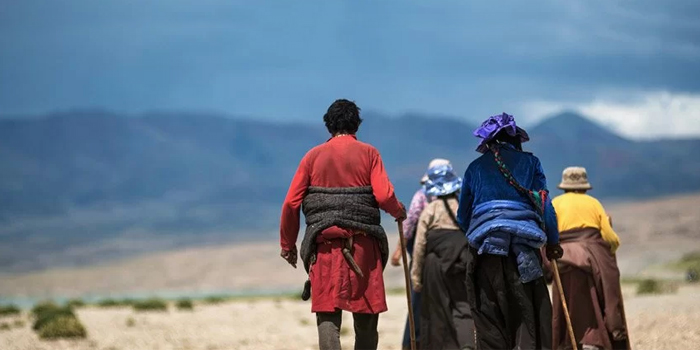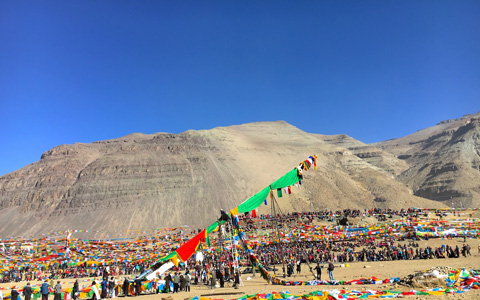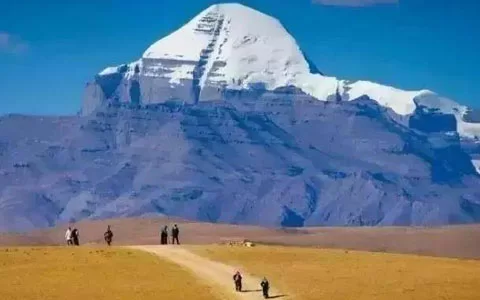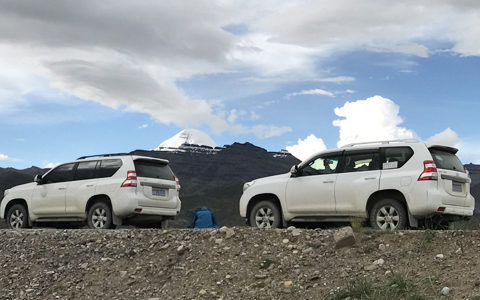Kailash Yatra Road Conditions: How are the Road Conditions for a Mt. Kailash Tour
Traveling from Lhasa to Mount Kailash for the Kailash Yatra is a big part of the experience. The Tibetan Plateau’s breathtaking scenery is on full display as the route passes through central Tibet and Mount Everest areas from Lhasa to the far west Ngari Plateau.
Passing through remote areas might have you wondering what it’s like getting there. Here, we’ll answer how are the road conditions for a Mount Kailash Tour.
 1. How is the Kailash Yatra/Tour Trekking Road Condition?(Approximately 44 km trekking in total)
1. How is the Kailash Yatra/Tour Trekking Road Condition?(Approximately 44 km trekking in total)
 2. How is the Lake Manasarovar Yatra/Tour Trekking Road Condition?
2. How is the Lake Manasarovar Yatra/Tour Trekking Road Condition?
 3. How is the Road Condition from Darchen to Kailash Trekking Start Point?
3. How is the Road Condition from Darchen to Kailash Trekking Start Point?
 4. How is the Road Condition from Lhasa to Mt. Kailash?
4. How is the Road Condition from Lhasa to Mt. Kailash?
 5. How is the Road Condition from Kathmandu to Mt. Kailash via Gyirong?
5. How is the Road Condition from Kathmandu to Mt. Kailash via Gyirong?
1. How is the Kailash Yatra/Tour Trekking Road Condition?(Approximately 44 km trekking in total)
The Kailash Mansarovar Yatra Tour involve three days of trekking around Mount Kailash. Altogether, it’s around 44 km of trekking through a range of different conditions.
Trek Day 1: Darchen to Dirapuk Monastery
The first day of trekking is along the valley at the base of Mount Kailash. Starting from the base of the southern slope, the 13 km trek is relatively easygoing. The trail has a moderate incline but, with good hiking boots, doesn’t present a big challenge. You’ll be treated to stunning views of the southern, southwestern, and western slopes and arrive at Dirapuk monastery to stay overnight.
 The first day of trekking is along the valley at the base of Mount Kailash.
The first day of trekking is along the valley at the base of Mount Kailash.
Trek Day 2: Dirapuk Monastery to Zutulpuk Monastery
Day 2 is the most challenging day of trekking. The route begins with a rapid climb, trekking 4 km from the monastery to reach 5,430 meters. Then, there is another 2 km ascent to the highest point, Dolma La Pass, at 5,630 meters. At these high altitudes, the trail is icy and scattered with rock all year round. You need to be cautious during the steep ascent. The views of Guri Kund, the emerald-green Lake of Compassion, and breathtaking views of the northwest slope are well worth the effort. The remaining part of the day’s 24 km is the gradual descent to Zutulpuk Monastery.
Trek Day 3: Zultupuk Monastery back to Darchen
On day three, you’ll complete Mount Kailash Kora with a more leisurely 12 km trek. There are some moderate ascents and descents along uneven paths on the way back to Darchen. After day 2, however, the shorter trek will feel easy, and you’ll finish in the morning.
2. How is the Lake Manasarovar Yatra/Tour Trekking Road Condition?
The Lake Mansarovar Yatra is a much easier trek. The 88 km kora takes around three days to complete. Circling the lake is a dirt road perfect for the trek. The road is covered in gravel and some debris but is mostly level. Gentle rolling hills are the only uphill climbs you’ll encounter, and these ascents are shallow and gradual. There is very little traffic, making for a pleasant walk around the lake.
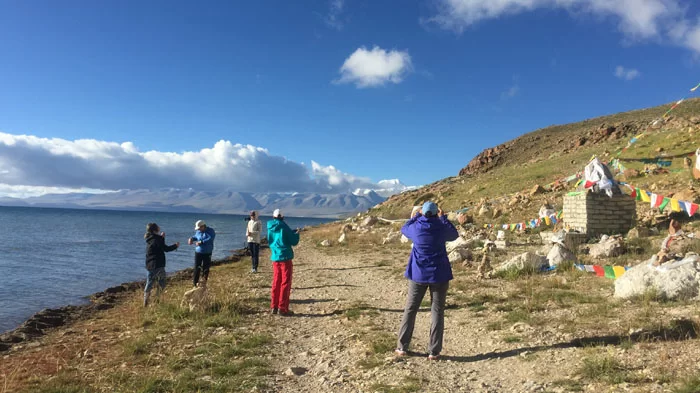 Lake Mansarovar Yatra tour.
Lake Mansarovar Yatra tour.
You have the option of taking a bus around Lake Mansarovar for a short kora. The gravel road makes for relatively smooth driving. In good weather conditions, the route around the holy lake takes around 3 hours, depending on how many stops to see the monasteries along the way.
3. How is the Road Condition from Darchen to Kailash Trekking Start Point?
The jumping-off point for Kailash trekking is the small town of Darchen at the foot of Mount Kailash. The trek actually begins at Sarshung Valley, which is only around 8 km away. On the first day, you'll take an eco-bus to get there. The roads are mostly paved, and the bus is well-equipped to handle them. On the smooth ride there, you’ll be able to relax and take in the scenery before trekking begins.
 The Darchen town at the foot of Mount Kailash.
The Darchen town at the foot of Mount Kailash.
On the 3rd day, completing to Kora, you can hike or take a bus for the last 5 km back to Darchen. The road is mostly gravel with some debris. As a final hike, it is not difficult. The choice depends on weather conditions that day and how tired you are after the Kailash Yatra. With the rough roads, the bus ride can be less comfortable than on Day 1. See how you feel when you get there.
4. How is the Road Condition from Lhasa to Mt. Kailash?
There are two main routes from Lhasa to Mount Kailash. The southern route passes through Shigatse, Saga, and then on to Darchen. Lhasa to Shigatse is a very smooth route. You can expect good infrastructure along the G318 Friendship Highway, with paved highways and well-maintained roads. Driving to EBC in Saga continues to follow the G318 Friendship Highway, so it is an easy and smooth drive all the way.
Conditions change a little from Saga to Darchen. Parts of the route might pass over gravel tracks or unpaved roads. Travel is safe, but some sections pass over rough terrain, especially as you get closer to Darchen.
 The Road from Lhasa to Mt. Kailash.
The Road from Lhasa to Mt. Kailash.
The northern route is longer and passes through several different areas. The first part is from Lhasa to Namtso Lake. It is a leisurely drive the whole way along well-paved roads. From Namtso to Baingoin, the road can be bumpy or muddy when it rains.
Except for small sections of paved roads, it is gravel and dirt roads most of the way from here. Through stunning Nyima and Wenbu South Village, there are times when the route is only vehicle tracks through the grasslands. Four-wheel drive vehicles are recommended as the stretch from Coqen to Ringtor passes through areas with swamps where vehicles can get stuck in the mud.
In the legs of the journey, Ringtor to Yagra and Yagra to Darchen, slower driving is advised. It is easy to get lost in uninhabited areas where signage is not always clearly marked. In dry weather, clouds of dust from the gravel roads can obscure visibility. Some travelers prefer to drive in the company of other vehicles for safety.
5. How is the Road Condition from Kathmandu to Mt. Kailash via Gyirong?
The drive from Kathmandu to Mount Kailash via Gyirong is a four-day journey that passes over varying road conditions. Part one of the journey is from Kathmandu to the Nepal-Tibet border at Gyirong. Reaching the border town takes about 7 hours of driving. Parts of the route are on smooth, well-paved highways, but it gets rougher as you near the border. Passing through Langtang National Park, in particular, is a very bumpy section. The muddy roads can be challenging, but the scenery and the chance to see wild animals make it an exciting part of the trip.
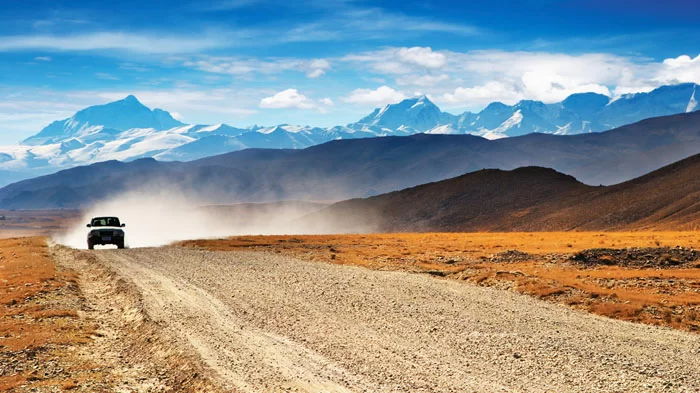 The Road from Kathmandu to Mt. Kailash Nepal side.
The Road from Kathmandu to Mt. Kailash Nepal side.
Conditions remain a little rough when crossing the border at Gyirong. Roads on the Tibetan side are initially unpaved. Continuing towards Saga, conditions improve gradually as you journey into parts of Tibet with better infrastructure. The 380 km stretch passes through fantastic scenery with dense forests and snow-capped mountains.
The final section from Saga to Darchen continues with a mix of road conditions. Parts will be along well-maintained paved roads, but expect some rough gravel tracks the closer you get to Mount Kailash.
Conclusion
Tibet contains some of the most remote areas on the planet. Areas with heavier traffic, such as the highways that branch out from Lhasa, generally have good, smooth roads. The further you go, the more likely you will encounter unpaved gravel tracks over rough terrain. But those remote places are where some of the best sights are to be found, and thousands of people make the journeys safely and comfortably every year.

Dawa,an excellent tour guide in our company, was born in 1976 in shigatse, where the home of Mt. Everest. Before being a guide, Dawa learnt Buddhism, Tibetan culture as well as English in a college for 10 years. After finished study, he became a tour guide in our company CITS, and had being a guide for more than 11years. His great knowledge about Tibet and its unique culture attracts tourists from all over the world. Would you like to come joining us with Dawa and take a unique experience in Tibet?
Related Articles & Posts
Most Popular Tibet Tour Packages
-

Lhasa - Gyantse - Shigatse - E.B.C - Saga - Kailash Trek - Darchen - Lake Manasarovar - Saga - Gyirong - Tingri - Lhasa
USD2059
View Details -

13 Day Lhasa, Mt. Everest, Mt. Kailash, Lake Manasarovar and Kathmandu Adventure Tour
Lhasa - Gyantse - Shigatse - EBC - Saga - Darchen - Kailash Trek - Darchen - Saga - Gyirong - Kathmandu
USD2059
View Details -

Lhasa - Gyantse - Shigatse - EBC - Saga - Darchen - Kailash Trek - Darchen - Saga - Gyirong - Tingri - Lhasa
USD2209
View Details -

17 Days Kailash Manasarovar Full Moon Tour & Guge Kingdom Exploration
Lhasa - Gyantse - Shigatse - EBC - Saga - Darchen - Zanda - Kailash Trek - Darchen - Saga - Gyirong - Tingri - Lhasa
USD2290
View Details -
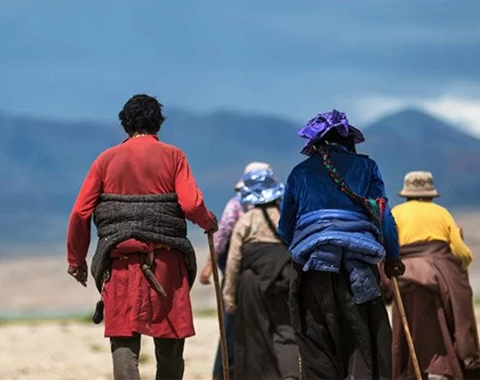
10 Days Kailash Pilgrimage Tour from Kathmandu, via Gyirong Port
Kathmandu – Gyirong – Saga – Mt.Kailash – Lake Manasarovar – Darchen – Saga – Gyirong – Kathmandu
USD1749
View Details -

Lhasa - Gyantse - Shigatse - Everest Base Camp - Shigatse - Lhasa
USD939
View Details -

Lhasa - Gyantse - Shigatse - Everest Base Camp - Gyirong - Kathmandu
USD979
View Details -

8 Days Driving Across Himalaya Overland Adventure from Kathmandu to Lhasa
Kathmandu - Gyirong - Everest Base Camp - Tingri - Shigatse - Gyantse - Lhasa
USD1069
View Details


.jpg)




